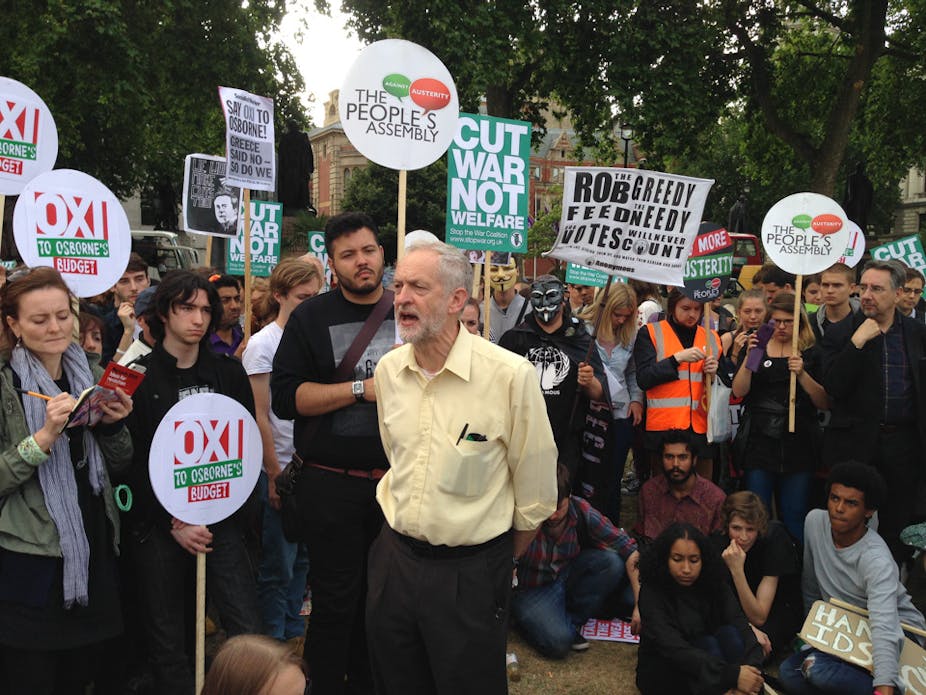One of the strongest criticisms levelled at Jeremy Corbyn, the anti-austerity left-winger currently leading in the contest to become the next leader of the Labour party, is that he is just not electable.
Former prime minister Tony Blair has waded into the debate to warn against supporting Corbyn, strongly implying that Labour would not win under him.
If Corbyn were to win the leader election, and if he were to shift the party to the left on issues such as public ownership, taxation and welfare. Is there any evidence that such policies would be electorally popular?
Jez he can
On the face of it there is some evidence of public support for what might be seen as leftist policies. A YouGov poll in November 2014, for example, found 56% of the electorate supported nationalising utilities such as gas and electricity. A full 59% supported nationalising the railways.
There is also some evidence that the public has tired of austerity. A poll taken just after the government’s July budget, for example, found that 51% thought limiting public sector pay rises to 1% for the next four years was the “wrong priority”.
There is even some evidence that the left may represent the largest single group in the electorate. In March 2015, 30% of YouGov respondents indicated that they thought of themselves as left of centre, while 24% thought of themselves as on the right.
No he can’t
Unfortunately, this rosy view of the electorate, does of course ignore its fundamental ambivalence. For every survey question that implies a leftish electorate, there is another (or indeed more) that provides precisely the opposite impression.
The post-budget poll, for example, also suggested that there was 84% support for the Conservative policy of increasing personal income tax allowances. There was also 54% support for increasing the inheritance tax thresholds and even 46% support for freezing working-age welfare payments.
And while it is true that 30% of YouGov respondents thought of themselves as left of centre, 15% of that 30% indicated that they thought of themselves as only slightly left of centre. In total 50% thought of themselves as centre-left, centrist or centre right (and a further 26% declined to accept any label). The political extremes are occupied by party members, bloggers and political hacks. The political centre is stuffed full of ordinary – voting – people.
Shifting left and right
Since it is always possible to cherry pick individual survey items, it is far better to weigh all the evidence. And since the ideological balance of opinion depends on the question that is posed, it is far better to focus on changing responses to the same question over time.
The below graph summarises responses to more than 700 questions and 5,000 observations on a wide range of survey items that are standardised to produce a single estimate of the policy mood – the electorate’s average preferences across all issues – from 1964 to the present day. Higher scores represent a more left-wing electorate, lower scores a more right-wing electorate.

We can see that the aggregate preferences of the electorate evolve over time. The pattern in the earlier period is a little confused but from 1974 onwards it is clear that the electorate moves right under Labour governments (1974-9 and 1997-2010) and left under Conservative governments (1979-97 and 2010-15).
Focusing on the past five years, it can be seen that the electorate has – and contrary to the pronouncements of Liz Kendall and Blair – very definitely moved to the left. Indeed, the electorate is now collectively where it was in 2005 when New Labour won its third successive victory.
But if Labour was to move further to the left it would reduce or eliminate this slowly accumulating advantage. A lurch to the left would open up a space and provide the Liberal Democrats with an opportunity to re-establish itself as a party of the centre left.
A leftward movement would also have consequential impacts on Labour’s reputation for economic competence, in particular further eroding business support for any social democratic programme.
Corbyn’s strategy of moving left has also been tried twice before – in February 1974 and 1983. In both elections, these moves were associated with massive reductions in Labour’s share of the vote and a dramatic rise in support for the parties of the centre.
And in any case, the British political agenda will be dominated by the Conservative party for the next five years. David Cameron and George Osborne have sought – perhaps implausibly – to portray themselves as centrists on issues such as welfare reform. They are likely to continue to produce policy proposals designed to embarrass Labour by forcing it to adopt positions supported by minorities.
If Corbyn were able to shift Labour to the left, it may energise a new generation of activists, help break Labour’s association with sleaze and the unpopular Iraq war. But in virtually every other respect, it will be electorally damaging.
The Labour party does not have a right to exist. It can no longer rely on vast reserves of tribal support. Blair’s warning that Labour can only win by occupying the centre is, therefore, a case of right message, wrong messenger.

